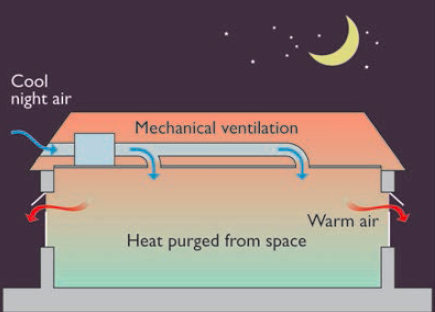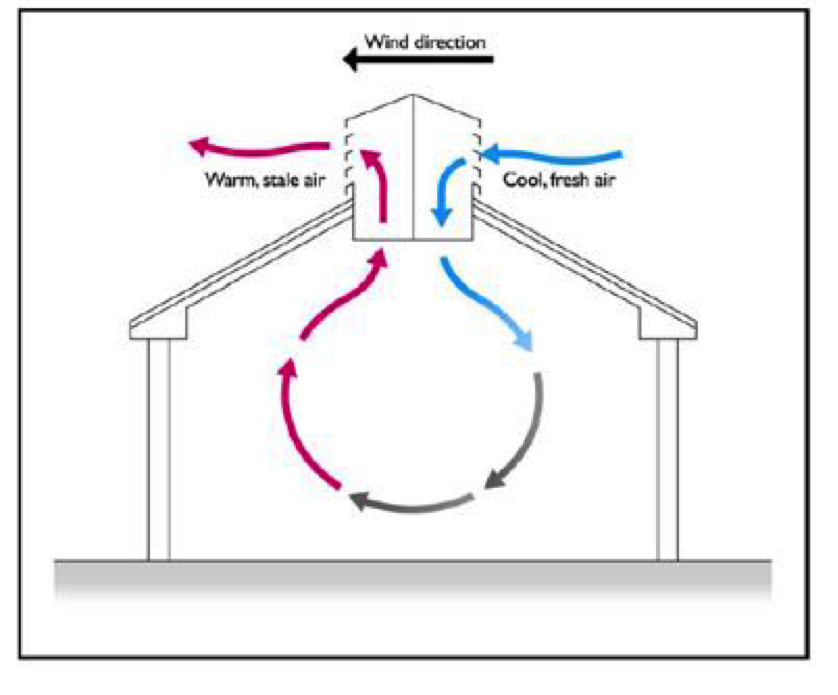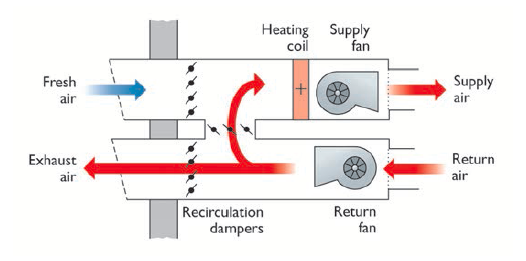
How do we deal with hot weather in the UK or getting rid of latent warm air without spending huge amounts of energy and money on air-conditioning systems? Although natural ventilation is the commonly low-cost practice to cool a building efficiently during the summer, mechanical ventilation in theory appears to be more efficient due to several reasons that are explored in this article.
Mechanical Ventilation advantages over natural ventilation
Mechanical ventilation can be retrofitted to almost every house and a large number of commercial premises to promote fresh air into spaces and then remove any latent heat. As previously discussed (reference to natural ventilation article), natural ventilation is based providing fresh air to a building through openings such as windows and doors. The way it works will depend on the type of the openings and the layout of the building.

The big issue with natural ventilation is that with glazing causes solar gain and in the summer months if this is excessive, it can cause local discomfort. In this case, mechanical ventilation would be more effective because it provides a more homogeneous effect due to a more even distribution of air.
The other issue with natural ventilation is that it can lead to excessive cooling capacity of rooms and again this may be worse / better depending on the building layout.
Mechanical ventilation reduces noise and air pollution
Mechanical ventilation is the only option when the building is located in noisy areas or in areas where the local air quality is poor, and therefore the use of openable windows for natural ventilation is not a practical solution. It is worth noting that security considerations may also lead to the use of mechanically assisted ventilation in many buildings as it allows the units to be securely locked.
However mechanical ventilation can be a costly solution
Mechanical ventilation definitely has merits over natural ventilation, but the issue comes to retrofitting a solution to a building, which could add quite a bit to the cost. This is why if possible mechanical ventilation is designed into the building plans, so that the costs to implement kept to a minimum.
Also, many companies lease the buildings that they occupy, so the decisions about the facilities management are taken out of their control. Landlord in turn would find it hard to invest in a system that would require significant funds but not so obvious quantifiable benefits.
The next section deals with some of the practical mechanical ventilation solutions and brief explanations on how they actually work.
Mechanical Ventilation Solutions
The simplest forms of mechanical ventilation systems simply circulate the air at the ceiling level, for example ceiling fans. They create air movement at the ceiling level to cool the space.
We may also have roof ventilators with louvers that help cold air enter the house and warm air to be exhausted as can be seen in Figure 1.
The roof ventilators can also be solar assisted to enhance the stack effect by increasing the air temperature in the top of the house. As mentioned before in natural ventilation the stack effect is based on temperature difference within the space and the outside air – the hotter it is at the top of the building the quicker the latent warm air is allowed to escape.
Ducts can be used to supply air to different levels of a multi-storey building, using underfloor or displacement ventilation that provide fresh air from floor-mounted or low-level wall mounted ventilators within the occupied rooms or zones.
In addition ventilated façade systems that are installed in the window frames such as those that can be seen in Figure 3 can also be classed in the mechanical ventilation family.
Supply and extract systems
Fan-assisted extracts work by enhancing the air movement to exhaust latent heat when the internal temperature is high.
Mechanical ventilation systems can have both supplier and extract vents assisted by fans as can be seen in the next se of figures. These systems may also include filters to ensure a higher standard of indoor air quality, coupled with heating and/ or cooling coils. When installing these systems they need to be ideally positioned into spaced to take into account occupational density and well as tackling cold draughts.
Mechanical extract only systems are used mostly when the air becomes contaminated such as in kitchens, bathrooms etc – where there is a need for constant and predictable extraction of air. Supply only systems are suitable for houses and occupied offices that need to be supplied by fresh air when the air movement needs to be controlled.
Other mechanical ventilation systems
Another option for mechanical ventilation systems is to go for mixed-mode ventilation where the system works in conjunction with natural ventilation. It corresponds well to the operational performance of the occupied buildings providing indoor air quality and preventing summer overheating.
Mixed mode ventilation can reduce annual energy use by over 41% with 19% of this reduction is due reduced night cooling of the building. Night ventilation is enhanced by mechanical systems that ensure an adequate level of airflow to remove heat gains during night.
Summary of mechanical ventilation
To sum up, the main reasons why mechanical ventilation wins over natural ventilation:
- The layout buildings does not help natural ventilation because the spaces are too deep to be ventilated from the perimeter or the air paths are being mitigated by the internal partitions.
- Natural ventilation absorbs any poor local air quality if present whereas mechanical ventilation can filter these pollutants out.
- Mechanical ventilation will allow less noise pollution to enter the building via openings such as windows.
- Highly dense areas will not have enough wind velocity to pump enough air flow into a building.
- Mechanical ventilation increases security as the building unit can be more sealed.
Some of the mechanical ventilation solutions explored
- Roof ventilators
- Ducts to encourage underfloor or displacement ventilation
- Ventilated façade systems
- Supply and extract systems
- Mixed mode ventilation
Cost / benefit of mechanical ventilation
Mechanical ventilation if designed into the plans of the building is a great concept – however to retrofit a solution may be too expense to implement.
Reference: BSRIA, The Illustrated Guide to Mechanical Building Services



















hello could you please help im interested in this system and want to know where i can find out who does this where i am. we live in the norfolk east anglia area
Hello If you want ventilation system, you could connect me.
RES AIR LTD
THEFORD
IP24 3RL 01842 753068
I think it would be great if you could cover MHRV, my parents have a flebu/villavent system which they installed 20 years ago in there conventional but well insulated self-build. Aside from the benefits of recovering the heat from the extracted warm air (bathrooms. kitchen,etc) and providing fresh air (bedrooms, living rooms) because it is constant ventilation all year round, you never had issues with condensation or dampness, never any need to open windows in winter, and cloths dry inside on an airer in 24hours. Magic.